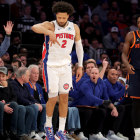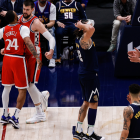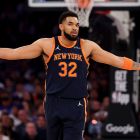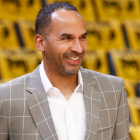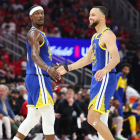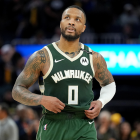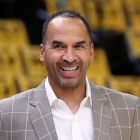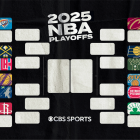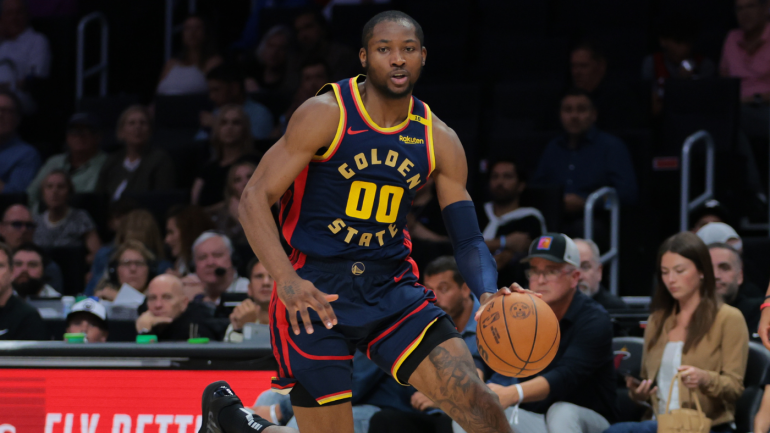
Sometimes, albeit rarely, a short-term injury can prove clarifying to a team looking for its identity. This is the scenario that the Golden State Warriors just lived. Jonathan Kuminga sprained an ankle in early January. A month later, the Warriors acquired Jimmy Butler. Kuminga and Butler, as athletic forwards who don't shoot many 3s, are awkward fits together. With Kuminga out, though, the Warriors could focus fully on integrating Butler. In his first 14 games in Golden State, Butler went 12-2. Kuminga returned for game No. 15. Since then, the Warriors are 10-5.
That's not bad by any means, but when you key in on Butler and Kuminga, specifically, the fit has been awkward. The two of them have played 120 minutes together, and Golden State has lost those minutes by 30 points. That duo has played 38 minutes alongside Draymond Green, another frontcourt player who doesn't shoot especially well. Together, the three of them have been outscored by 26 points.
These are small samples, of course. You could take the numbers on their own and trust three very good players to figure it out with time. But the Warriors don't have time. They're fighting for their playoff lives now, and their head coach, Steve Kerr, just openly admitted to Willard & Dibs on 95.7 The Game that lineup combinations featuring all three are not working. When asked about reintegrating Kuminga, Kerr acknowledged that he has prioritized Butler and that, at least thus far, those three forwards just haven't been able to play together.
"Every game is different, and I think, Jimmy's arrival took away a lot of Jonathan's minutes at the four," Kerr explained. "There's no doubt that as soon as Jimmy arrived and we started winning, we leaned into lineup combinations that enhanced Jimmy because we were winning. Jonathan was out for that whole stretch, we went like 17-3 or something, so we're gonna keep doing what's been winning. But the lineup with Jimmy, Jonathan and Draymond doesn't fit real well, frankly, we need more spacing, we've found other lineups that have clicked, and that's just part of the deal being in the NBA.
"You've gotta adapt to whatever's happening with the team," he continued. "Jonathan's done a great job of that. He's working hard, he's playing well when he's out there. I'm just going with the lineup combinations that I think are gonna give us the best chance to win. There's gonna be nights where he's absolutely part of that like the Laker game, and there's gonna be nights where I go to Buddy, or Moses, or Gary Payton. It just changes every game based on what's happening, and I have to read that as a coach."
The Warriors have had more leeway with lineup decisions than any other team in the NBA for the past decade. Stephen Curry grants it. No other shooter in all of basketball comes close to approaching his gravity. Golden State has gotten away with playing more non-shooters next to him than most teams could even dream of. But even Curry has his limits, especially without a second Splash Brother to amplify those spacing benefits.
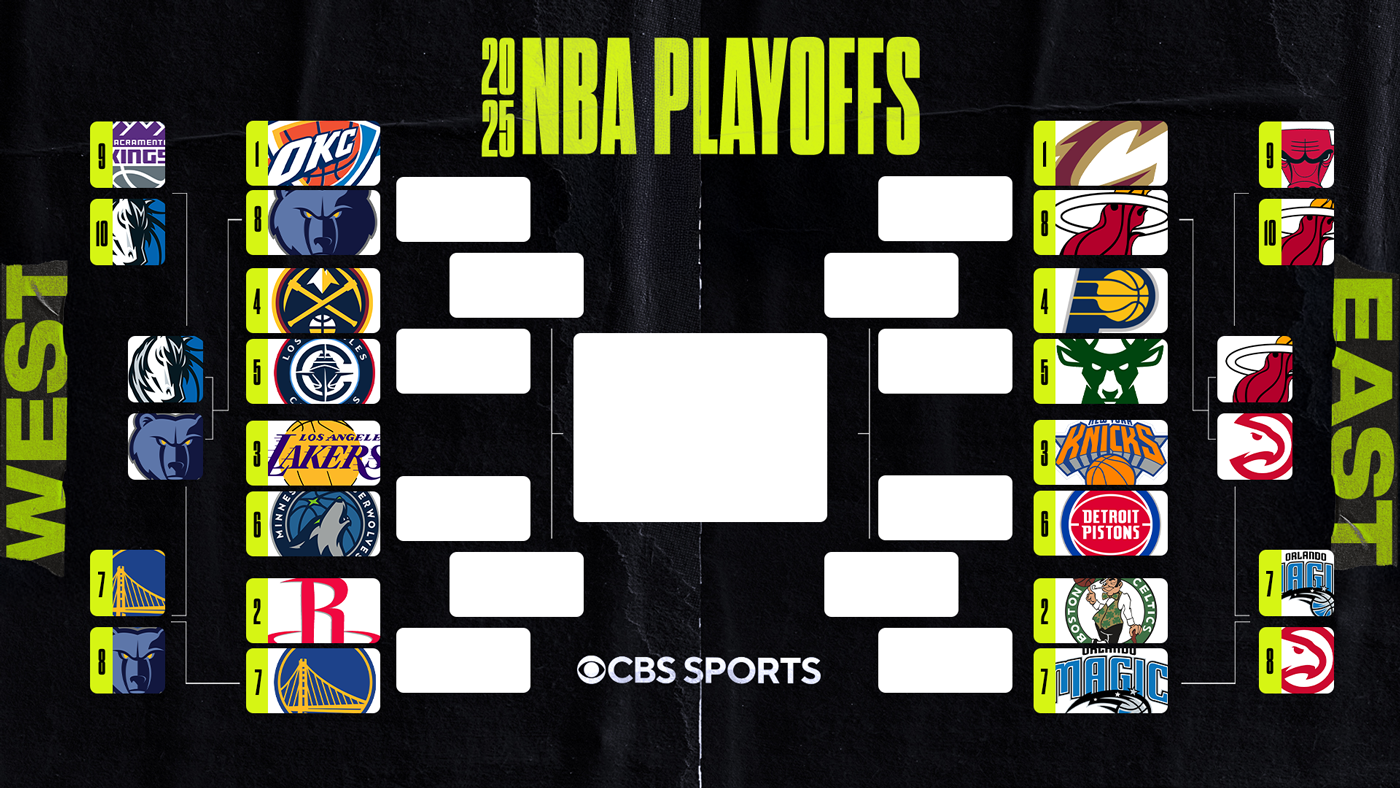
The things that Butler and Green do well require some measure of space. Both are high-level playmakers. Butler is an interior scorer that wants defenses in flux so he can take advantage by drawing fouls. They are both at their best with shooters zooming around them, pulling defenders into compromising positions that they, with their enormous basketball IQs, can punish. Kuminga doesn't fit the bill. He's not a shooter. He's not an especially potent cutter, either. At this point of his career, Kuminga is an athlete and a driver. He wants the ball in his hands so he can go downhill, ideally to get to the rim, but potentially also to pull into mid-range jumpers. It's harder to do that when Butler and Green don't need to be defended as much as better shooters behind the arc. The three of them have conflicting skill sets.
Yet the three of them all have needed skill sets. The Warriors were a Play-In team before Butler's arrival. There's a reason Golden State has put up with all of Green's extracurricular nonsense for more than a decade now. His playmaking unlocks their offense and his versatility and intelligence is their defense. They are not negotiable. Kuminga? That's a bit more complicated. That 12-2 stretch suggests that the Warriors can win without him. Kerr was right about the other players at his disposal. Brandin Podziemski, Buddy Hield and Gary Payton II make more sense in a vacuum.
But for everything the Warriors -- who have the third-shortest odds to win the Western Conference at +750 on FanDuel -- do have with both their stars and those role players, what they generally lack is athleticism. Curry, Green and Butler are old. Podziemski and Hield are underwhelming athletes. Payton is a bit springier, but at 6-foot-2, there's only so much he can do with it.
Kuminga is in another universe, a power forward that runs like a shooting guard and jumps like a center. That opens up quite a bit for Golden State in transition, and in the right matchups, like that Laker game Kerr mentioned, it's lethal. Good luck keeping Kuminga away from the rim without a center. Under different circumstances, he'd be a perfect Curry complement. Drivers and spacers are an easy match. Golden State's unusual roster has always complicated that dream.
You can mix-and-match your way through a single postseason. It's not ideal, of course, but Butler and Green won't play 48 minutes. Kerr can insert Kuminga in advantageous lineups when they present themselves. It wouldn't exactly optimize him, but as Kerr said, he's thinking about the team, not the individuals. Kuminga himself is in a somewhat different position.
He's a restricted free agent this offseason. He figures to be an expensive one. More traditional rosters dream of talents like Kuminga. Golden State has resisted trading him for four years, but they've been able to treat him as a luxury in that time because of his cheap rookie contract. That contract expires after the season. They already owe roughly $150 million to five players next season: Curry, Butler, Green, Moody and Hield. Paying Kuminga his market rate and filling out the roster would take the Warriors deep into the luxury tax almost certainly above the second apron.
Joe Lacob has paid hefty tax penalties before, but never with the roster-building limitations that the aprons represent in his way. Perhaps the Warriors could re-sign Kuminga planning to trade him for cheaper assets later, but that's never a certainty. Sign-and-trades come with a host of cap complications for both sides. There are always creative solutions to these problems. The Warriors found one when Kevin Durant left, turning his salary slot into D'Angelo Russell, and eventually, Andrew Wiggins and Kuminga himself. Again, that was in a different cap environment.
In this one, paying top-dollar for someone who doesn't fit with your second- and third-best player is probably impossible... even if you think he might one day be your best player. That's the issue at the center of all of this. Kuminga, even as a prospect, was distinctly un-Warriors-like player. Franz Wagner was the cleaner fit. But Golden State saw Kuminga as a rare talent, one they normally wouldn't have access to drafting at the back of the first round. They drafted him for a future they assumed would be here by now. It isn't. The Curry-Green-Butler present is the priority. It will be for the foreseeable future.
That Laker game offered a glimpse into some of the ways these two timelines are converging. Podziemski and Moody are melding perfectly with the older players. It hasn't been as clean for Kuminga. It may never be, and time is running out for him to prove it could be. If he doesn't, if Kerr can't figure out how to make it work between him, Butler and Green, his time as a Warrior might be coming to an end.
![[object Object] Logo](https://sportshub.cbsistatic.com/i/2020/04/22/e9ceb731-8b3f-4c60-98fe-090ab66a2997/screen-shot-2020-04-22-at-11-04-56-am.png)










